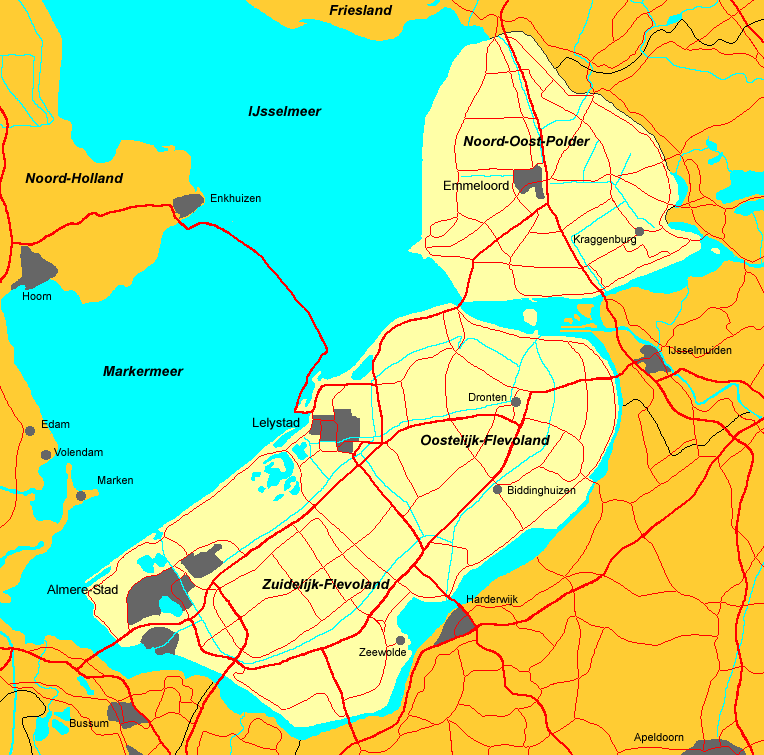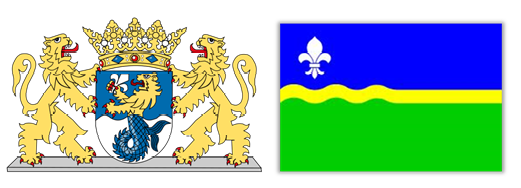The name Flevoland is derived from the Flevomeer (Lake Flevo) that, in Roman times, covered the the centre of the area. It is the youngest province of the Netherlands. It was created in 1986 (after a very long battle against the Zuiderzee) and added as the 12th province to the Kingdom of the Netherlands.
The province borders to Friesland (North), Overijssel (east), Gelderland (east and south), Noord-Holland (south and west) and consists of three parts: the North-eastern polder (Noordoostpolder), the Eastern-Flevoland (Oostelijk-Flevoland) and a Southern-Flevoland (Zuidelijk-Flevoland). Its capital city is Lelystad.
The construction of the fourth polder “Markerwaard” was abandoned because of an expected strong increase in demand of freshwater in the Netherlands in the near future, due to the climate change. Today that area is called Markermeer. The remainder of the former Zuiderzee is called IJsselmeer. The province has a population density of 279 inh./km²
Provincial coat of arms Provincial flag
The provincial coat of arms has two Dutch lions as supporters and is covered with a counts crown. The shield shows the Dutch lion (top) on the abdomen of a (dike-eater) waterwolf. The lion has a lily in the right claw as a tribute to Cornelis Lely as who as engineer designed the reclamation and as minister among others got the law on the execution (even without a roll call vote) agreed in parliament. This symbolism is also shown in the name of the provincial capital and on the provincial flag.
Provincial broadcast: (Radio F) & (TV Flevoland).
Flevoland in a birdseye. & Weather in Flevoland & Weather warnings in Flevoland.
The Flevolandian “states” (parliament) (photo’s).
Tourisme in Flevoland.
Anthem: Flevoland.
Dutch English
-1- -1-
Waar wij steden doen verrijzen, Where we do arise cities,
op de bodem van de zee. on the bottom of the sea.
Onder Hollands wolkenhemel, Under the Dutch clouded sky,
tellen wij als twaalfde mee. we count as number twelve.
Refrein Refrain
-2- -2-
Land gemaakt door mensenhanden, Land made by human hands,
vol vertrouwen en met kracht. with confidence and strength.
Waar de zee werd teruggedrongen, Where the sea was pushed back,
die zoveel verschrikking bracht. who brought so much horror.
Refrein Refrain
-3- -3-
De natuur laat zich hier gelden, Here nature takes its rights,
dieren kiezen nest of hol. animals choose nest or den.
En de wijde vergezichten, And the wide vistas,
stemmen ons zo vreugdevol. make us so joyfully.
Refrein Refrain
Refrein Refrain
Een provincie die er wezen mag, A province to be proud of,
‘t jongste stukje Nederland. the youngest part of the Netherlands.
Waar het fijn is om te leven, Where the living is fine,
mijn geliefde Flevoland. my beloved Flevoland.
The history of Flevoland
Although the province was only recently made it has virtually no history. But its roots are nevertheless in Roman times. It was here that the early Dutch, showed that their tribes were not without power. Writing about them Tacitus speaks of Frisian farmers but from other sources we know also other tribes rushed to their aid. In particular, the Batavians learned here the lessons how to address later (in 69 AD, the birth of the Dutch nation) the Romans.
The battle of Castellum Flevum
Tacitus wrote:
In the year 28 AD the Frisii, a people north of the Rhine, have broken the peace, not primarily because of dissatisfaction with their servitude, but because of our greed. Drusus, the Roman general who subdued the Frisians, imposed on them only a limited burden – in accordance with their resources, namely the supply of cattle hides for military use, nobody cared about the strength or size of them, until Olennius a centurion, was entrusted by the military leadership with the administration of the Frisii, took the skins of wild animals as a standard for the provision. This tax, that was a heavy task to other tribes, was to the Germans even more difficult because they had only smaller sized cattle. First, they gave their cattle, then their crops and eventually their women and children were claimed as slaves. That caused a great rage, and they decided to go to war. Soldiers who came to collect the tax, were seized and crucified. Olennius himself fled into a fortress called Flevum to escape the tormented peasants. However, also there Olennius was not safe, because the farmers attacked the fort from two sides: from the south and from the north. The southern attack was repulsed, but at the north side the farmers came in the fortress. After that two other groups of Frisians tried to get into the fort: one from the northeast and the other across the river. They were both defeated. Finally, the Frisians who had entered the fort were chased into the water.
The Battle of Baduhenna
After the battle at the fort the uprising was continued. Also elsewhere in the region the Romans were chasing the Frisians. They needed to build bridges to get their heavy weaponry over the creeks of the estuary. So the Frisians were in favor. They were lightly armed (shields and spears) and knew the wetlands of their hand, they lured the Romans ever deeper into the estuary. According to Tacitus, a great battle, took place in what was called the “… quae apud lucum Baduhenna …” (Baduhenna’s forest). – Nine hundred Romans were killed by the Frisian arms and four hundred were killed by own troops “each because of treason suspectations” – wrote Tacitus.
Moderne tijd: Batavia werf / Lowlands
Han Tiggelaar


